#Asia's Nightingale
Explore tagged Tumblr posts
Text

Nehamah Lifshitz performing in Kaltowa, Lithuania, 1949
Nehama Lifshitz (1927 – 2017), often called “the Jewish Nightingale”, was a world-renowned Yiddish folk singer from Kaunas, Lithuania. She survived the Holocaust by fleeing east to Uzbekistan and returned to Kaunas after the war. Performing all over Eastern Europe and Central Asia, her concerts were the heart and soul of Lifshitz’s contribution to keeping Jewish culture and identity alive in the repressive Communist bloc. As a result, she encountered frequent hostility from Soviet officials, who deemed her art as "nationalistic", "pessimistic" and "unsociacialistic".
278 notes
·
View notes
Text

Today, 12 May, is International Nurses' Day, in honour of Nightingale's birthday. The International Nurses' Convention, which is held every four years, was held in Japan for the first time in Asia in 1977 (1977), and a commemorative stamp was issued.
今日5月12日はナイチンゲールの誕生日にちなんで、「国際看護師の日」だそうです。 4年に1度開催される国際看護婦大会が1977年(昭和52年)にアジアで初めて日本で開催され、記念切手が発行されました。当時の看護婦の呼称は、現在では看護師に改称されています。
36 notes
·
View notes
Text
Great Backyard Bird Off - Schedule & Info
Round One Schedule
Cosmopolitan - posted February 1st & 2nd - 14 polls
Europe - posted February 11th - 9 polls
Africa - posted February 20th - 9 polls
Australia - posted March 1st & 2nd - 20 polls
New Zealand - posted March 11th - 7 polls
Asia - posted March 20th & 21st - 14 polls
the Americas - posted March 29th & 30th - 16 polls
Eurasia - posted April 8th & 9th - 14 polls
Poll Info
There are 8 brackets, with 208 species featured! Ranges were determined either using the self-report feature added to the submission box or with eBird sightings. "Cosmopolitan" is a bracket involving species of birds which were found on at least three continents, regardless of which they were submitted for. "Eurasia" are birds which seem to appear equally between Europe and Asia (majority of the continent, not just Middle East). "the Americas" includes all of the Americas, with US birds removed- granted, some Canadian or Mexican birds can show up in the US, but they're not common enough backyard birds (imo) to have been disqualified.
Please-- feel free to advocate for whichever bird you vote for! I would love to get some more participation with this tournament, especially since this is a poll with popular bird species.
Polls will be a week long, and are tagged #Great Backyard Bird Off. All subsequent reblogs are tagged as #poll reblog. Be sure to block this tag if you want to avoid me spamming your dash. Any reblogs containing support for a species will be tagged #[species] support. Results will be tagged #poll results.
Bird Support Google Form
vvv Participant List under the Read More vvv
Cosmopolitan (28 species)
Black kite, Black-headed gull, Bohemian waxwing, Canada goose, Common buzzard, C. Chiffchaff, C. Kingfisher, C. Loon, C. Myna, C. Nightingale, C. Swift, Eurasian Collared-dove, Eurasian Hoopoe, Eurasian (Common) Kestrel, Eurasian Tree Sparrow, European bee-eater, European (common) starling, Great crested grebe, Great gray owl, Grey wagtail, Little grebe, Ring-necked pheasant, Red-backed Shrike, Rock Pigeon, Rose-ringed Parakeet, Western barn owl, Western cattle egret, White (pied) wagtail
Europe (18 species)
Tawny Owl, Spotless Starling, Red kite, Middle spotted woodpecker, Great spotted woodpecker, Fieldfare, European Stonechat, E. Robin, E. Herring Gull, E. Goldfinch, Eurasian Green Woodpecker, Eurasian Golden Oriole, Eurasian blackcap, Eurasian (Common) Blackbird, Dunnock, Crested tit, Common wood-pigeon, Eurasian Blue tit
Africa (18 species)
African Harrier-hawk, Bearded barbet, Blacksmith lapwing, Bokmakierie, Cape starling, Cape white-eye, Dark-capped bulbul, Hadada ibis, House bunting, Klaas' Cuckoo, Kwevoel (Grey go-away-bird), Nile valley sunbird, Purple-crested turaco, Red-winged starling, Southern double-collared sunbird, Southern masked weaver, Spotted eagle-owl, White-backed mousebird
Australia (41 species)
Yellow Wattlebird, Willie-wagtail, White-faced Heron, Welcome Swallow, Weebill, Tawny Frogmouth, Tasmanian Nativehen, Superb Fairywren, Sulfur-crested Cockatoo, Splendid Fairywren, Sooty Owl, Red-browed Firetail, Red wattlebird, Rainbow lorikeet, Peid currawong, Pheasant coucal, Pacific koel, Noisy miner, Masked lapwing, Magpie-lark, Little corella, Lewin's honeyeater, Laughing kookaburra, Grey fantail, Grey butcherbird, Gang Gang cockatoo, Galah, Eastern spinebill, Eastern rosella, Crimson rosella, Crested pigeon, Crescent honeyeater, Bush stone curlew (thick-knee), Brown thornbill, Black swan, Bell miner, Austarlian ringneck, Australian magpie, Australian Ibis (Bin Chicken), Australasian Swamphen (Pukeko)
New Zealand (14 species)
Kaka, Kakaruwai (South Island robin), Karearea (NZ falcon), Kereru, Koekoea (Long-tailed Koel), Korimako (NZ bellbird), Yellowhead, Piwakawaka (NZ Fantail), Riroriro (Grey Gerygone), Satin Bowerbird, Silvereye (Tahou), Titipounamu (Rifleman), Tomtit, Tui
Asia (28 species)
Asian Koel, Azure-winged Magpie, Black-collared Starling, Brown-eared Bulbul, Colombo (House) Crow, Common Hill-myna, Eastern Buzzard, Japanese Robin, Light-vented Bulbul, Mandarin Duck, Masked Laughingthrush, Olive-backed Sunbird, Oriental Magpie-robin, Oriental Pied Hornbill, Palau Fruit dove, Palla's Gull, Purple-rumped Sunbird, Red-billed Blue magpie, Red Junglefowl, Red-whiskered bulbul, Ruppell's Weaver, Southern Hill-myna, Spotted dove, Swinhoe's White-eye, Whistling Green-pigeon, White-rumped munia, White-spectacled bulbul, Yellow bittern
The Americas (33 species)
Austral Thrush, Bananaquit, Blue-and-white Swallow, Blue-and-yellow Macaw, Bushy-crested Jay, Canada Jay, Chalk-browed Mockingbird, Chimango, Clay-colored Thrush, Common Potoo, Crimson-fronted Parakeet, Eared Dove, Great Kiskadee, Great Thrush, Green-backed Firecrown, Green-headed Tanager, Hoatzin, Lesson's Motmot, Masked Water Tyrant, Pacific Hornero, Pale-breasted Thrush, Plain Parakeet, Red-rumped Cacique, Ruddy Ground Dove, Rufous Hornero, Rufous-bellied Thrush, Rufous-collared Sparrow, Russet-naped Wood rail, Sayaca Tanager, Southern House Wren, Southern Lapwing, White Bellbird, White-crested Elaenia
Eurasia (28 Species)
Black Redstart, Blue Rock thrush, Carrion Crow, Coal Tit, Common Chaffinch, Eurasian Bullfinch, Eurasian Bittern, Eurasian Jackdaw, Eurasian Jay, Eurasian Magpie, Eurasian Nuthatch, Eurasian Oystercatcher, Eurasian Siskin, Eurasian Sparrowhawk, Eurasian Treecreeper, Eurasian Wren, European Greenfinch, Goldcrest, Great Tit, Hawfinch, Hooded Crow, Long-tailed Tit, Mistle Thrush, Northern Lapwing, Rook, Song Thrush, Spanish Sparrow, Yellowhammer
#great backyard bird off#poll info#tbf this post is as much for me as it is for yall#i just need to get better at planning bc of school and all#but I really love running this blog#hopefully this poll is big enough to carry us through most of the year!
12 notes
·
View notes
Text

Ek Sadi, Ek Awaaz, Ek Lata Mangeshkar’ Today, we remember Lata Mangeshkar on her 95th birth anniversary (28/09/1929). Born Hema Mangeshkar on 28 September 1929, she became one of the most celebrated singers in independent India, with her influence reaching far beyond its borders. Her voice united the people of South Asia, transcending boundaries. With a career spanning eight decades, Lata Ji’s immense contribution to Indian music earned her prestigious titles such as the "Queen of Melody," the "Nightingale of India," and the "Voice of the Millennium." She recorded songs in over thirty-six Indian languages, including Marathi, Hindi, and Bengali, as well as a few foreign languages.
11 notes
·
View notes
Note
Oh actually there’s running gag in how convenient that a lot of historical figures are in one game
AC syndicate is one of the most infamous, because despite it taking over a year. We meet Frederick Abberline, Charles Dickinson and Darwin(actually there a lot of tongue meta jokes with him. As his theory of evolution is still accurate in ac. He doesn’t know that humanity to primatesto what dogs are to wolves), Karl Marx (sadly you can’t kill him), Alexander Graham Bell, Nightingale, and the motherfucking Queen Victoria
Not counting dlc with Arthur Doyle and Deup Singh
And yes we do have dlc centered around Jack the Ripper
Oh shit I forgot there ww1 segment where you work with Winston Churchill
Another thing, so in the halo series, there a propaganda line of “Spartans never die, there just Missing In Action”
It took Herdotus in odyessy, yes the Father of History (or Lies to the Egyptians), saying that Spartan poem of them being immortal I went
“Wait that where halo got it from?!”
Actually leaks said William Adams is going to be in the game too. I presuming third act or late game, wait could Adams travel to other places after becoming a samurai? I can see him being used a mechanic to explain how we can go to other countries like India
Btw I meet Rolo of Normandy in Valhalla when he was 17…in a medieval bdsm dungeon while he blindfolded and wiped
Dear god Middle Ages England was truly the apocalypse
Also I only realize it after the endgame…young Rolo actually lives in my settlement for a bit
But yeah I can see them making up a relationship with Yasuke and William Adams. Oh another joke
A Japanese: another Gajin join us?’
Yasuke: Yes and make him a proper samurai this time
Oh this is Valhalla main menu theme. But rest to sure the ac red music will be authentic
https://youtu.be/bApSPN-5TxQ?si=FcMKeReMxCuxGpxW
Hell the teaser trailer I sent actually ends with the game Japanese cover of ac iconic song ezio family
Lots of stuff ending with Oh shit I forgot there ww1 segment where you work with Winston Churchill
Doyle and Churchill don't quite fit, Deup Singh either but in the other direction
It took Herdotus in odyessy, yes the Father of History (or Lies to the Egyptians), saying that Spartan poem of them being immortal I went “Wait that where halo got it from?!”
Josephus is a good historian to read too, and it's entirely possible that's where they got it, not sure the poem tho so can't say for sure.
Actually leaks said William Adams is going to be in the game too. I presuming third act or late game, wait could Adams travel to other places after becoming a samurai? I can see him being used a mechanic to explain how we can go to other countries like India
Ya Tokegawa let him go back to England even at some point, he had freedom of movement probably had to still have permission from the boss to leave Japan but well
List of foreign-born samurai (Yasuke doesn't make the cut because they can't 100% prove he was or wasn't a samurai.) but this list goes through their credentials or however you want to put it.
For Addams it was
250 koku. He was granted the rank of Hatamoto, a fief and 80-90 servants. Interpreter and shipwright of Tokugawa Shogunate.
Only one managed a higher worth.
Btw I meet Rolo of Normandy in Valhalla when he was 17…in a medieval bdsm dungeon while he blindfolded and wiped Dear god Middle Ages England was truly the apocalypse
Not just in Europe either, though that's where we have the specific information about things, shit was bad in Asia, the middle east, and Africa too. Lots of those areas had the same problem too.
But yeah I can see them making up a relationship with Yasuke and William Adams. Oh another joke A Japanese: another Gajin join us?’ Yasuke: Yes and make him a proper samurai this time
I take it Yasuke managed to pick up the language ok then, Addams did ok but still had a interpreter with him all the time too just in case.
youtube
Oh that's pretty
Hell the teaser trailer I sent actually ends with the game Japanese cover of ac iconic song ezio family
I didn't catch that apparently, that's cool af
3 notes
·
View notes
Text
Sweet Nightingale

One of the neat side effects about my job writing guides for Rock Paper Shotgun is getting exposed to stuff that I don't typically touch. For example, the survival/crafting genre, which blew up in the 2010s when I was living in Asia and too busy trying to survive in real life. I was aware of games like The Long Dark, of course, and I thought Valheim looked okay when it came out. But as someone who's never been thrilled with the idea of chopping down digital trees for wood (except for maintaining my farm in Harvest Moon 64), survival games have mostly fallen off my radar.
Obviously, that's no longer the case thanks to work. Survival games are perhaps one of the few video game genres out there that remain opaque as hell, therefore making them perfect fodder for guide writing. And this year has already seen several big survival games released, with Palworld taking up far more of my mental space than I ever would've imagined for much of January and February. (My lukewarm take is that Palworld is okay. Not really my thing, but I get why people like it as both a meme game and a "I can't believe Nintendo isn't suing, because that Electrabuzz ripoff is equipped with a GUN, somebody stop him!")
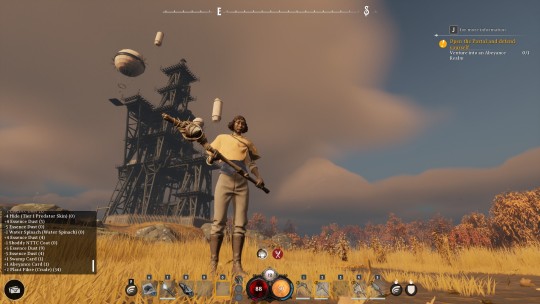
But this post is not about Palworld. It is, rather, about Nightingale, an enchanting survival title made by Inflexion Games that unfortunately launched into Early Access only a few weeks after Palworld probably stole some of its potential player base. I had the chance to consume a fair bit of Nightingale prior to its release, and I also wrote a few guides on it for work. I'm not sure if it's actually going to take off - its current player numbers aren't as high as expected, and the game bristles with a special degree of enrapturing jank that's definitely not going to appeal to everyone. Case in point: half of my colleagues hated the pre-Early Access UI, which made several unusual decisions, including flipping the usual hotbar configuration present in these sorts of games. This has since been rectified, and now the UI is more streamlined and accessible, though also a bit more boring, in my eyes.
I think Nightingale sticks with me precisely because it boasts an aesthetic and setting that are very much not boring. We're talking about a gaslight fantasy atmosphere that feels a tad Neil Gaiman, if he were channeling the same stuff that inspired Alan Moore to write The League of Extraordinary Gentlemen. Apparently, Nightingale's concept was based on the novel Jonathan Strange & Mr. Norrell, which I have not read but now want to, and the game starts by placing you as an inhabitant of a late 1800s reality inextricably linked with Fae beings. A big calamity happens, and folks exploring the Faewilds are tossed into disparate realms and separated from their magical hub city, dubbed Nightingale. You have to help your character survive in these bizarre biomes, which are filled with Wonderland-style beasts and floating sculptures in the sky. Hopefully by constructing your own estate in these magical outposts and allying with other Realmswalkers, all of you will one day reach the city of Nightingale once more.
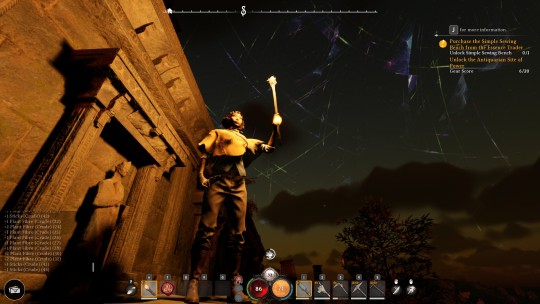
I am an absolute pervert for this sort of alternate history Victorian stuff, and if I'm going to be very frank, my initial reaction when playing Nightingale was wondering if its enchanting setting was "wasted" on a survival/crafting game. It's the sort of thing I'd expect to see in a tabletop RPG (which I would gladly play), not a game where you need to construct a sewing table and then kill 5 hippos so you can skin their hides and put those hides on the aforementioned sewing table and wait a minute so you can craft a little cape for yourself.
I'm not the only one to have this thought, and there's a whole calvacade of commentators who posted similar things on every Rock Paper Shotgun article devoted to the game. In a nutshell, it seems to come down to the fact that many outspoken individuals don't like the survival gameplay loop of running around chopping down trees so you can craft a better axe to chop down more trees, but thus far they've safely been able to ignore most crafting games because they typically take place in forests or post-apocalyptic environments that are usually pretty samey. Nightingale is not samey, which makes people want to play it and then lament that it's not in their ideal genre of choice.

Once again, I really need to expoud upon how much charm this game has. Your guide through the tutorial is a smooth talking fey with a poncy vocabulary named Puck. Umbrellas serve as in-game gliders to make you descend from great heights like Mary Poppins. And even though the basic survival loop is there - yes, you've still got to farm those damn hippos - there is a nifty tarot card system in place that procedurally generates the worlds your intrepid Realmswalker is forced to confront. It's a mishmash of ideas that really feels like it's ripped from the pages of some Game Master's steampunk world (there I go again, going off on how much I'd like to play a Nightingale TTRPG), and even though it's largely busywork, eventually you can get a rifle that shoots ice ammo and a legendary set of "armor" that's really just a Victorian tweed suit. By damnation, it's appealing.
It's this sense of originality that makes me want to play Nightingale more, and injects within me the strength to overlook the jankiness in the combat and UI that make me ocasionally feel like I'm playing a game from the late 2000s. (The first Witcher, are ya there? I'm reminded of you.) And I daresay it's unfair to say that Nightingale's eclectic setting is "wasted" on a survival/crafting experience, which is a harsh statement that probably does a disservice to both Inflexion Games and to the entire genre. While these sorts of games might not be my automatic cuppa, Nightingale actually makes me want to play more of them, and I plan on purchasing V Rising next month, which I missed out on back when it came out.
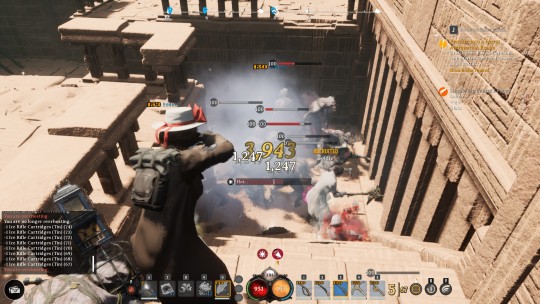
All this is a roundabout way of saying that there's power in a good setting and a striking coat of paint. Sometimes that's all we need to overlook gameplay loops that do not initially appeal to us, and I'm sure there's a whole audience out there that cared little for crafting in the wilderness but loved monster collecting. Palworld was the honeypot that probably encouraged them to look deeper into what survival games had to offer. For me, Nightingale performs a similar function.
There's also the fact that I appreciate it when games take risks and dare to step outside of the cornerstones of what's considered safe and sellable in their respective genres. Nightingale probably wouldn't have stood out nearly as much as a CRPG, for instance. There are already gaslight fantasy RPGs out there, and you can still buy Arcanum: Of Steamworks and Magick Obscura on Steam. But there's nothing quite like this in the survival space, and thus we have something brave and bold, unique and odd - a potent combination that compels me to stay a while in its mysterious Fae red room. I certainly hope that Nightingale survives its turbulent Early Access period, because while chopping down trees and building houses might not be what I'm immediately looking for when I sit down to play a game, stick a tophat on me and say I'm doing it in the realm of A Midsummer Night's Dream and my mind has the potential to change. It's all about the flavor, in other words, and Nightingale has that in spades.
5 notes
·
View notes
Text
Happy birthday, Faye Wong: 4 of the Hong Kong Cantopop star’s career and personal highlights (2023)
As Faye Wong turns 54, we look back at how she captured people’s hearts in Asia by being herself and focusing on one thing: her music
She had sold nearly 10 million albums by 2000 and has starred in several movies, including Chungking Express, for which she won a best actress award
by Nicole Tan
No one can say Faye Wong didn’t do it all her own way.
Born in Beijing in 1969, the singer and actress – who turns 54 today – went from not knowing a word of Cantonese to becoming a beloved Hong Kong music star to being honoured by Time magazine as one of the “divas of pop”.
She’s known for avoiding the spotlight and keeping a limited public presence, yet Wong’s undeniable talent has cemented her as one of Asia’s most popular divas, one that will be remembered for decades to come.
Here are some of her career milestones and major achievements.
She claimed her place in the Guinness World Records
Wong was one of the first women to dominate Hong Kong’s music industry.
By 2000 she had sold about 9.7 million copies of her 20 studio albums, making her, according to Guinness World Records, the bestselling female Cantopop artist of all time.
2. She was never one for spectacle – and it still paid off
Whereas other singers would put on elaborate concerts filled with dancing and extravagance, Wong focused on delivering one thing to audiences: her music.
Fans flocked to her performances to be mesmerised by her nightingale voice, one that brought her accolades including 2004’s best female artist in Hong Kong and Taiwan, awarded by the Top Chinese Music Awards.
Her 2003 concert tour, “No Faye No Live”, sold 30,000 tickets within three days, setting a Hong Kong record at the time.
3. She remained unapologetically herself, even in the limelight
Wong drew praise – and controversy – for her uncurated and authentic public image.
Fans admired her for being a “modern” woman, independent and unbothered by what A-list celebrities or agents might have to say.
She married Beijing rock star Dou Wei in 1996 in what the public deemed an “unlikely” pairing. Today, many criticise her relationship with actor Nicholas Tse – which they rekindled in 2014 after dating from 2000 to 2003 – but Wong remains unapologetic in her pursuit of love.
4. She also left her mark on Hong Kong cinema
Wong starred in several movies, including Wong Kar-wai’s 1994 comedy-drama Chungking Express, 2002’s Chinese Odyssey, and 2004’s 2046.
Her portrayal of Faye in Chungking Express, a young woman with an unusual approach to romance, won her the best actress award at the 1994 Stockholm Film Festival.
Although Wong maintains a low profile, the career she has built for herself over the span of almost three decades is rediscovered time and time again today. It is this legacy that one of her daughters, 26-year-old singer Leah Dou, looks to carry on.
——————————————————————
SOURCE: SOUTH CHINA MORNING POST
8 notes
·
View notes
Text
Coloratura soprano Alma Fohström von Rode (1856–1936) was one of the most internationally successful Finnish opera singers in the end of 19th century.
Alma Fohström was born in Helsinki in 1856. She studied singing with Anna Blomqvist in Helsinki and with Henriette Nissen-Saloman (1819–1879) in Saint Petersburg. Fohström graduated from Petersburg Conservatory in 1877. The young singer arrived to Milan in May 1878 to study with vocal teacher Francesco Lamperti (1813–1892). Later she studied with Felice Varesi (1813–1889) and took master classes with Désirée Artôt (1835–1907).
Fohström made her operatic debut at the Finnish Opera in Helsinki in 1878 as Marguerite in Gounoud’s Faust. Her career rapidly became international in scope. She performed in South and North America, in Europe, Russia and Asia. In the late 19th century, Alma Fohström appeared at the Academy of Music in New York, at La Scala in Milan, at Kroll Theatre and Opera House in Berlin, at Colon Theatre in Buenos Aires, at Imperial Theatre in Rio de Janeiro, at the Metropolitan Opera in New York, at Mariinsky Theatre in Saint Petersburg, at Bolshoi Theatre in Moscow, at the Covent Garden in London and in many other opera houses.
Fohström cut 4 gramophone recordings of songs at Pathé studio in Saint Petersburg in 1902. Only one of them has remained, Aleksandr Aljabjev’s song «Nightingale”.
Finnish Nightingale Alma Fohström was one of the famous sopranos in the late 19th century due to the purity and beauty of her lyrical voice and the high quality of her bel canto technique. Her voice had perfectly equalized vocal registers and a silver tone. Regarding her voice, international music critics said that Nordic prima donna Alma Fohström had a crystalline, and a very high soprano voice. Her vocal range was wide from low a to high F (a–f3) . Alma Fohström’s repertoire included 40 opera roles. She sang in the title role of Donizetti’s Lucia di Lammermoor and Amina in Bellini’s La Sonnambula. Fohström proved to be an effective actress in those lyric roles that required the summoning forth of deep emotions, such as Verdi’s Gilda in Rigoletto and Violetta in La Traviata.
Songstress announced her retirement from the stage in 1904. She spent the rest of her life teaching singing, in 1910th in Saint Petersburg conservatory, in 1920th in Schtern’s conservatory in Berlin and from 1928 in Helsinki conservatory. Alma Fohström died in Helsinki in 1936.
#opera#classical music#music history#bel canto#composer#classical composer#aria#classical studies#classical singer#metropolitan opera#met#Alma Fohström#Fohström#Finnish Nightingale#Alexander Alyabyev#Alyabyev#The Nightingale#coloratura soprano#soprano#classical singing#classical musician#classical musicians#classical history#chest voice#diva#prima donna#maestro#musician#musicians#Covent Garden
4 notes
·
View notes
Text
Hetalia characters as Arknights races
Forget Hogwarts houses, let's assign an animal to each nation!
Decided according to either national animals or real species that are common in / are associated with the nations
Arknights (Check out this game!) has lots of races, but you don't really need to worry about knowing what they are because they are just real-life animals and mythical beings/creatures
Main cast
Italy Veneziano - Lupo - Italian wolf
Germany - Liberi - white-tailed eagle
Japan - Kylin (qilin race)
America - Liberi - bald eagle
China - Lung (Chinese dragon)
England - Aslan (lion race)
France - Liberi - Gallic rooster
Russia - Ursus - Eurasian brown bear
Central Europe
Austria - Caprinae - mountain goat
Czechia - Itra - Siberian musk deer
Hungary - Liberi - saker falcon
Liechtenstein - Caprinae - mountain goat
Poland - Kuranta - Konik
Prussia - Sarkaz ("demon" race)
Slovakia - Ursus - brown bear
Switzerland - Caprinae - mountain goat
Mediterranean Europe
Cyprus - Caprinae - Cypriot mouflon
TRNC - Caprinae - Cypriot mouflon
Greece - Aegir - dolphin
Italy Romano - Lupo - Italian wolf
Portugal - Vouivre - green wyvern
Spain - Forte - Spanish fighting bull
Turkey - Perro - Kangal Shepherd Dog
Western Europe
Belgium - Cautus - Holland Lop
Ireland - Cautus - Irish hare
Knights Templar - Sankta ("angel" race)
Luxembourg - Cautus - Netherland Dwarf rabbit
Monaco - Zalak - wood mouse
Netherlands - Cautus - Dutch rabbit
Northern Ireland - Liberi - owl
Scotland - Kuranta - unicorn
Wales - Draco - red dragon
Nordic Europe
Denmark - Liberi - mute swan
Finland - Ursus - brown bear
Iceland - Kuranta - Fjord horse
Norway - Kuranta - Fjord horse
Sweden - Elafia - Eurasian elk
Eastern Europe
Belarus - Forte - European bison
Bulgaria - Vulpo - red fox
Estonia - Liberi - barn swallow
Latvia - Liberi - white wagtail
Lithuania - Liberi - white stork
Moldova - Feline - lynx
Romania - Feline - lynx
Ukraine - Liberi - nightingale
Asia
Hong Kong - Ursus - panda
India - Liberi - Indian peafowl
Indonesia - Savra - Komodo dragon
South Korea - Feline - Korean tiger
Macau - Liberi - black-faced spoonbill
Malaysia - Feline - Malayan tiger
Philippines - Liberi - Philippine eagle
Singapore - Aslan - Asiatic lion
Taiwan - Ursus - Formosan black bear
Thailand - Cerato - elephant
Vietnam - Forte - water buffalo
Africa
Cameroon - Aslan - northern lion
Egypt - Feline - Abyssinian
Seychelles- Liberi - Seychelles black parrot
Egypt - Feline - Abyssinian
Seychelles- Liberi - Seychelles black parrot
N/S America + Oceania
Canada - Zalak - North American beaver
Cuba - Liberi - Cuban trogon
Ecuador - Petram - Galapagos tortoise
Australia - Zalak - red kangaroo
New Zealand - Liberi - kiwi
Notes:
Prussia is obviously inspired by Cardverse
Knights Templar is here instead of the other ex-immortals because I have a soft spot for him (he is literally an angel here, with a shotgun!!!)
I know, natural lions don't exist in Europe, but England (and many other Europeans) use them as their national symbols. I didn't want too many Aslans in the list and I decided that Netherlands (and his siblings) are better off as rabbits, and I can't think of anything else for Iggy, so he's the lion now
I will one day draw this AU because for some reason I'm starting to like [animal]boys and [animal]girls (NOT FURRIES, but ok maybe I'll draw the furry version as well because they exist in Arknights heh. An excuse to practise drawing animals lol)
I guess you COULD use this as a reference for an HP au because PATRONUSES
Ok, I'll admit, I love Eng and Port as a lion and a wyvern because look at this!!!

#hetalia#hetalia x arknights#arktalia#hws england#aph england#hws america#aph america#hws prussia#aph prussia#hws italy#aph italy#aph germany#hws germany#aph russia#hws russia#hws china#aph china#hws japan#aph japan#hetalia world stars#hetalia crossover#crossover#hws that's a lot of people#undeadrambles#aph portugal#hws portugal#// I might post a genshin crossover later lol
10 notes
·
View notes
Link
Coming across this video, I feel the deep down urge to perch and sing with the full range of my lungs, to chirp loud enough to be heard from a distance, uncaring of human listeners.
3 notes
·
View notes
Text
youtube
sensually eating a vegan hot dog...
Koncepcja i Realizacja: POSNIQ x Izabela Zubrycka Art Director & DOP: Natalia Pośnik Dir: Izabela Zubrycka Cast: Zofia Justyńska, Oskar Jankowski Kierownictwo produkcji: Julia Kałużna Kierownictwo produkcji II: Laura Einbacher 1AD/Kierownik planu: Laura Einbacher 2AD: Filip Pakuła Montaż: Igor Kaczmarek Kostiumy: Maja Wiśniewska Makeup artist: Iza Kućmierowska Scenografia: Michał Kiersnowski Kolor korekcja: Natalia Pośnik 1stAC: Jonasz Mularz 2ndAC/Focus puller: Merlijn Willemsen Gaffer: Mateusz Rzońca Oświetlacz: Maria Troczyńska 2nd unit: Jonasz Mularz, Izabela Zubrycka Wózkarz: Andrzej Szwed Samochód: Tomek Pawlik Fotosy: Zuzanna Mazurek / zuuzzzz
Wystąpili: KIWI Lola Noir - The Nightingale of Burlesque Oliwia Wasilewska Asia Dyrkacz Andrzej Sikorski Łukasz Zagrajek Michał Włodarczyk
Sprzęt oświetleniowy: Piramida Film Sprzęt kamerowy: ATM System
Podziękowania: PWSFTviT, Agata Golańska, Tatiana Matysiak, Marek Bystrosz
2 notes
·
View notes
Text
Saints&Reading: Tuesday, April 16, 2024
april 3_april 16
VENERABLE NICETAS THE CONFESSOR ABBOT OF MEDIKION (824)

Saint Niketas (Nikḗtas) the Confessor was born in Bithynian Caesarea (northwest Asia Minor) of a pious family. His mother died eight days after his birth, and his father Philaretos became a monk. The child remained in the care of his grandmother, who raised him in a true Christian spirit. From his youth Saint Niketas attended church and was a disciple of the hermit Stephanos. With his blessing, Saint Niketas set off to the Mydicia monastery, where Saint Nikephoros (Nikēphóros) (March 13) was the igumen.
After seven years of virtuous life at the monastery, famed for its strict monastic rule, Saint Niketas was ordained presbyter. Saint Nikephoros, knowing the holy life of the young monk, entrusted to him the guidance of the monastery when he himself became ill.
Not wanting power, Saint Niketas devoted himself to the enlightenment and welfare of the monastery. He guided the brethren by his own example. Soon the fame of the lofty life of its inhabitants of the monastery attracted many seeking salvation. After several years, the number of monks had increased to one hundred.
When Saint Nikephoros departed to the Lord in his old age, the brethren unanimously chose Saint Niketas as igumen.
The Lord granted Saint Niketas the gift of wonderworking. Through his prayer a deaf-mute child received the gift of speech; two demon-possessed women were healed; he restored reason to one who had lost his mind, and many of the sick were healed of their infirmities.
During these years under the emperor Leo the Armenian (813-820), the Iconoclast heresy resurfaced and oppression increased. Orthodox bishops were deposed and banished. At Constantinople a council of heretics was convened in 815, at which they deposed the holy Patriarch Nikephoros (806-815), and in his place they chose the heretical layman Theodotus. They also installed heretics in place of exiled and imprisoned Orthodox bishops.
The emperor summoned all the heads of the monasteries and tried to bring them over to the Iconoclast heresy. Among those summoned was Saint Niketas, who stood firmly for the Orthodox confession. Following his example, all the igumens remained faithful to the veneration of holy icons. Therefore, they threw him into prison. Saint Niketas bravely underwent all the tribulations and encouraged firmness of spirit in the other prisoners.
Then the emperor and the false patriarch Theodotus attempted to trick those who remained faithful to Orthodox teaching. They promised that the emperor would give them their freedom and permit the veneration of the icons on one condition: that they take Communion from the pseudo-patriarch Theodotus.
For a long time the saint had doubts about entering into communion with a heretic, but other prisoners begged him to go along with them. Acceding to their entreaties, Saint Niketas went into the church, where icons were put out to deceive the confessors, and he accepted Communion.
But when he returned to his monastery and saw that the persecution against icons was continuing, he then repented of his deed, returned to Constantinople and fearlessly denounced the Iconoclast heresy. He ignored all the emperor’s threats.
Saint Niketas was again locked up in prison for six years until the death of the emperor Leo the Armenian. Enduring hunger and travail, Saint Niketas worked miracles by the power of his prayers: through his prayer the Phrygian ruler released two captives without ransom; three shipwrecked men for whom Saint Niketas prayed, were thrown up on shore by the waves.
Saint Niketas reposed in the Lord in 824. The saint’s body was buried at the monastery with reverence. Later, his relics became a source of healing for those coming to venerate the holy confessor.
ST. JOSEPH THE HYMNOGRAPHER, OF SICILY (883)
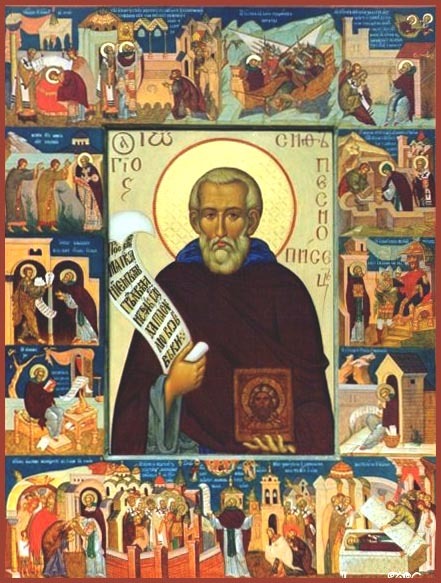
Saint Joseph the Hymnographer, “the sweet-voiced nightingale of the Church,” was born in Sicily around the turn of the 9th century into a pious Christian family. His parents, Plotinos and Agatha, moved to the Peloponnesos to save themselves from barbarian invasions. When he was fifteen, Saint Joseph went to Thessalonica and entered the monastery of Latomos. He was distinguished by his piety, his love for work, and his meekness; and he gained the good will of all the brethren of the monastery. He was later ordained as a priest.
Saint Gregory the Dekapolite (November 20) visited the monastery and took notice of the young monk, taking him along to Constantinople, where they settled together near the church of the holy Martyrs Sergius and Bacchus. This was during the reign of the emperor Leo the Armenian (813-820), a time of fierce iconoclast persecution.
Saints Gregory and Joseph fearlessly defended the veneration of holy icons. They preached in the city squares and visited in the homes of the Orthodox, encouraging them against the heretics. The Church of Constantinople was in a most grievous position. Not only the emperor, but also the patriarch were iconoclast heretics.
At that time the Roman bishops were in communion with the Eastern Church, and Pope Leo III, who was not under the dominion of the Byzantine Emperor, was able to render great help to the Orthodox. The Orthodox monks chose Saint Joseph as a steadfast and eloquent messenger to the Pope. Saint Gregory blessed him to journey to Rome and to report on the plight of the Church of Constantinople, the atrocities of the iconoclasts, and the dangers threatening Orthodoxy.
During the journey, Saint Joseph was captured by Arab brigands who had been bribed by the iconoclasts. They took him to the island of Crete, where they handed him over to the iconoclasts, who locked him up in prison. Bravely enduring all the deprivations, he encouraged the other prisoners. By his prayers, a certain Orthodox bishop who had begun to waver was strengthened in spirit and courageously accepted martyrdom.
Saint Joseph spent six years in prison. On the night of the Nativity of Christ in 820 he was granted a vision of Saint Nicholas of Myra, who told him about the death of the iconoclast Leo the Armenian, and the end of the persecution.
Saint Nicholas gave him a paper scroll and said, “Take this scroll and eat it.” On the scroll was written: “Hasten, O Gracious One, and come to our aid if possible and as You will, for You are the Merciful One.” The monk read the scroll, ate it and said, “How sweet are Thine oracles to my throat” (Ps 118/119:103). Saint Nicholas bade him to sing these words. After this the fetters fell off the saint, the doors of the prison opened, and he emerged from it. He was transported through the air and set down on a large road near Constantinople, leading into the city.
When he reached Constantinople, Saint Joseph found that Saint Gregory the Dekapolite was no longer among the living, leaving behind his disciple John (April 18), who soon died. Saint Joseph built a church dedicated to Saint Nicholas and transferred the relics of Saints Gregory and John there. A monastery was founded near the church.
Saint Joseph received a portion of the relics of the Apostle Bartholomew from a certain virtuous man. He built a church in memory of the holy apostle. He loved and honored Saint Bartholomew, and he was distressed that there was no Canon glorifying the holy Apostle. He desired to adorn the Feast of Saint Bartholomew with hymns, but he did not dare to compose them himself.
For forty days Saint Joseph prayed with tears, preparing for the Feast of the holy apostle. On the eve of the Feast the Apostle Bartholomew appeared to him in the altar. He pressed the holy Gospel to Joseph’s bosom, and blessed him to write church hymns with the words, “May the right hand of the Almighty God bless you, may your tongue pour forth waters of heavenly wisdom, may your heart be a temple of the Holy Spirit, and may your hymnody delight the entire world.” After this miraculous appearance, Saint Joseph composed a Canon to the Apostle Bartholomew, and from that time he began to compose hymns and Canons in honor of the Mother of God, of the saints, and in honor of Saint Nicholas, who liberated him from prison.
During the revival of the iconoclast heresy under the emperor Theophilus (829-842), Saint Joseph suffered a second time from the heretics. He was exiled to Cherson [Chersonessus] for eleven years. The Orthodox veneration of holy icons was restored under the holy empress Theodora (February 11) in 842, and Saint Joseph was made keeper of sacred vessels at Hagia Sophia in Constantinople. Because of his bold denunciation of the brother of the empress, Bardas, for unlawful cohabitation, the saint was again sent into exile and returned only after Bardas died in 867.
Patriarch Photius (February 6) restored him to his former position and appointed him Father-confessor for all the clergy of Constantinople.
Having reached old age, Saint Joseph fell ill. On Great and Holy Friday, the Lord informed him of his approaching demise in a dream. The saint made an inventory of the church articles in Hagia Sophia, which were under his official care, and he sent it to Patriarch Photius.
For several days he prayed intensely, preparing for death. He prayed for peace for the Church, and the mercy of God for his soul. Having received the Holy Mysteries of Christ, Saint Joseph blessed all who came to him, and with joy he fell asleep in the Lord in 886 (some sources say in 883). The choirs of the angels and the saints, whom Saint Joseph had glorified in his hymnology, carried his soul to Heaven in triumph.
In 890, his biographer John the deacon of the Great Church wrote about the spirit and power of Saint Joseph’s Canons: “When he began to write verses, then the hearing was taken with a wondrous pleasantness of sound, and the heart was struck by the power of the thought. Those who strive for a life of perfection find a respite here. Writers, having left off with their other versification, from this one treasure-trove, from the writings of Saint Joseph, began to scoop out his treasure for their own songs, or better to say, daily they scoop them out.
“And finally, all the people carry it over into their own language, so as to enlighten with song the darkness of night, or staving off sleep, to continue with the vigil until sunrise. If anyone were to peruse the life of a saint of the Church on any given day, they would see the worthiness of Saint Joseph’s hymns and acknowledge his glorious life. Actually, since the lives and deeds of almost every saint are adorned with praises, is not he worthy of immortal glory, who has worthily and exquisitely known how to glorify them?
“Now let some saints glorify his meekness, and others his wisdom, and others his works, and all together glorify the grace of the Holy Spirit, Who so abundantly and immeasurably has bestown his gifts on him.”
Most of the Canons in the MENAION are Saint Joseph’s work. His name may be found in the Ninth Ode as an acrostic. He also composed many of the hymns in the PARAKLETIKE.
Source: Orthodox Church in America_OCA

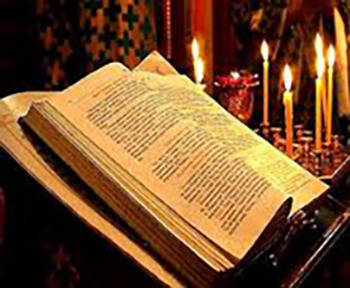
ISAIAH 40:18-31
18 To whom then will you liken God? Or what likeness will you compare to Him? 19 The workman molds an image, The goldsmith overspreads it with gold, And the silversmith casts silver chains. 20 Whoever is too impoverished for such a contribution Chooses a tree that will not rot; He seeks for himself a skillful workman To prepare a carved image that will not totter. 21 Have you not known? Have you not heard? Has it not been told to you from the beginning? Have you not understood the foundations of the earth? 22 It is He who sits above the circle of the earth, And its inhabitants are like grasshoppers, Who stretches out the heavens like a curtain, And spreads them out like a tent to dwell in. 23 He brings the princes to nothing; He makes the judges of the earth useless. 24 Scarcely shall they be planted, Scarcely shall they be sown, Scarcely shall their stock take root in the earth, When He will also blow on them, And they will wither, And the whirlwind will take them away like stubble. 25 “To whom then will you liken Me, Or to whom shall I be equal?” says the Holy One. 26 Lift up your eyes on high, And see who has created these things, Who brings out their host by number; He calls them all by name, By the greatness of His might And the strength of His power; Not one is missing. 27 Why do you say, O Jacob, And speak, O Israel: “My way is hidden from the Lord, And my just claim is passed over by my God”? 28 Have you not known? Have you not heard? The everlasting God, the Lord, The Creator of the ends of the earth, Neither faints nor is weary. His understanding is unsearchable. 29 He gives power to the weak, And to those who have no might He increases strength. 30 Even the youths shall faint and be weary, And the young men shall utterly fall, 31 But those who wait on the Lord Shall renew their strength; They shall mount up with wings like eagles, They shall run and not be weary, They shall walk and not faint.
GENESIS 15:1-15
1 After these things the word of the Lord came to Abram in a vision, saying, “Do not be afraid, Abram. I am your shield, your exceedingly great reward.” 2 But Abram said, “Lord God, what will You give me, seeing I go childless, and the heir of my house is Eliezer of Damascus?” 3 Then Abram said, “Look, You have given me no offspring; indeed one born in my house is my heir!” 4 And behold, the word of the Lord came to him, saying, “This one shall not be your heir, but one who will come from your own body shall be your heir.” 5 Then He brought him outside and said, “Look now toward heaven, and count the stars if you are able to number them.” And He said to him, “So shall your descendants be.” 6 And he believed in the Lord, and He accounted it to him for righteousness. 7 Then He said to him, “I am the Lord, who brought you out of Ur of the Chaldeans, to give you this land to inherit it.” 8 And he said, “Lord God, how shall I know that I will inherit it?” 9 So He said to him, “Bring Me a three-year-old heifer, a three-year-old female goat, a three-year-old ram, a turtledove, and a young pigeon.” 10 Then he brought all these to Him and cut them in two, down the middle, and placed each piece opposite the other; but he did not cut the birds in two. 11 And when the vultures came down on the carcasses, Abram drove them away. 12 Now when the sun was going down, a deep sleep fell upon Abram; and behold, horror and great darkness fell upon him. 13 Then He said to Abram: “Know certainly that your descendants will be strangers in a land that is not theirs, and will serve them, and they will afflict them four hundred years. 14 “And also the nation whom they serve I will judge; afterward they shall come out with great possessions. 15 “Now as for you, you shall go to your fathers in peace; you shall be buried at a good old age.
#orthodoxy#orthodoxchristianity#easternorthodoxchurch#originofchristianity#spirituality#holyscriptures#bible#oldtestament#saints
0 notes
Video
youtube
History of Ephesus Ancient City-Turkey-Explore 16 Mysterious Zones
E P H E S U S - HOLY MARY'S HOME CITY, IN HER LAST 9 YEARS OF LIFE ON EARTH.- MARY LIVED THERE FROM THE YEAR 39, TO 48 AD. AT FIRST, SHE LIVED IN THE DOWNTOWN, CLOSE TO A "HARBOR STREET" LEADING TO THE PORT OF EPHESUS, THEN THE SECOND LARGEST PORT IN THE EASTERN MEDITERRANEAN, AFTER ALEXANDRIA. THE "HARBOR STREET" WAS ONE OF THE MAIN STREETS OF EPHESUS, USED FOR TRADE AND SOCIAL ACTIVITIES, SURROUNDED BY VARIOUS SHOPS, TEMPLES AND MONUMENTAL STRUCTURES. WHEN JOHN THE APOSTLE, HAD THE HOUSE FOR HER ON THE SLOPE OF "NIGHTINGALE HILL", WHICH WAS STILL EPHESUS, COMPLETED, SHE MOVED THERE. THERE, SHE HAD AS HER CLOSE NEIGHBORS, WHO IN SOME INSTANCES, WERE ALSO HER CLOSE FRIENDS, THE REACHEST PEOPLE OF EPHESUS, WHO, AT THAT TIME WERE ALSO THE REACHEST PEOPLE OF THE WORLD. THESE PEOPLE LIVED OUTSIDE THE WALLS OF THE CITY IN TERRACE HOUSES, JUST ON THE SLOPE OF "NIGHTINGALE HILL", WHERE MARY LIVED IN HER HOUSE. /TO GET TO THE DOWNTOWN FROM HER HOUSE ON "NIGHTINGALE HILL", THE SLOPE OF WHICH WAS REACHING THE CITY WALLS, TOOK MARY ONLY SOME 30-MINUTE WALK/. THE 1st CENTURY AD EPHESUS, POPULATION OF A QUARTER MILLION PEOPLE (250 THOUSAND), SITUATED AT THE AEGEAN SEA (PRESENT DAY TURKEY), WAS THE REACHEST CITY OF A ROMAN EMPIRE - IT'S FINANCIAL AND CULTURAL CENTER. IT WAS THE SEAT OF A ROMAN GOVERNOR FOR THE EMPIRE'S EASTERN PROVINCE OF "ASIA MINOR" , AND WAS THE ACTUAL GATEWAY TO ASIA FOR ROME. LYING WHERE "THE WEST" AND "THE EAST" MEET, EPHESUS WAS A METROPOLY BUSTLING WITH PEOPLE OF DIFFERENT CULTURES AND FROM VARIOUS NATIONS. FOR THE GRECO-ROMAN WORLD, EPHESUS WAS THE CENTER OF THE CULT OF "ARTEMIS" - LOVE & FERTILITY GODDESS, LIKE "CYBELE" OR "ISIS", WITH HER ENORMOUS TEMPLE - THE BIGGEST OF THE ANCIENT WORLD, CONSIDERED AS ONE OF "THE SEVEN WONDERS OF THE WORLD".
0 notes
Text
Nature's Wonders: Exploring Animals That Start With 'N’
The natural world is filled with a diverse array of creatures, each with its own unique characteristics and contributions to the delicate balance of ecosystems. In this exploration, we turn our attention to the animals that start with n and discover a captivating collection of animals that start with this letter. From the depths of the ocean to the heights of the rainforests, let's delve into the lives of these fascinating creatures.
Narwhal
Kicking off our list is the narwhal, often referred to as the "unicorns of the sea." These intriguing marine mammals are known for their long, spiral tusks that can reach lengths of up to 10 feet. Found primarily in the Arctic waters, narwhals use their tusks for various purposes, including hunting for food and navigating through icy waters.
Newt
Venturing onto land, we encounter the newt. These small amphibians are well-known for their bright colours and unique skin texture. Newts go through a fascinating life cycle, starting as aquatic larvae before transforming into terrestrial adults. Their vibrant appearance serves as a warning to predators that they possess toxic skin secretions.
Nightingale
As the sun sets and darkness falls, the nightingale takes centre stage with its melodious and enchanting song. This small songbird is celebrated for its powerful and varied vocalisations, often associated with warm summer nights and poetic inspiration. Nightingales can be found in Europe, Asia, and Africa.
Numbat
Hailing from the Australian outback, the numbat is a striking marsupial with distinctive reddish-brown fur adorned with white stripes. This unique creature primarily feeds on termites, using its long tongue to extract the insects from their nests. The numbat's natural habitat is threatened, making it a symbol of conservation efforts in Australia.
Nudibranch
Diving into the ocean's depths, we encounter the mesmerising nudibranch. These colourful and often flamboyantly patterned marine gastropods are a wonder to behold. With their vibrant hues and intricate shapes, nudibranchs demonstrate the diversity of life beneath the waves.
Nile Crocodile
One of the apex predators of Africa's waterways, the Nile crocodile demands respect and awe. With its powerful jaws, armoured body, and exceptional hunting skills, this reptile is a symbol of both danger and the complex ecosystems it inhabits.
Nene
Endemic to the Hawaiian Islands, the nene is the state bird of Hawaii and a symbol of the islands' unique wildlife. Also known as the Hawaiian goose, the nene has managed to survive and recover from the brink of extinction, thanks to conservation efforts. Its name comes from its distinct "nay-nay" call.
Nutria
Originally native to South America, the nutria, also known as coypu, has established itself in various parts of the world due to human introductions. These semi-aquatic rodents are known for their webbed feet and coarse fur. While considered pests in some areas, they play a role in wetland ecosystems.
Conclusion
From the depths of the oceans to the vast landscapes of various continents, animals that start with the letter 'N' bring a sense of wonder and appreciation for the diversity of life on Earth. Each of these creatures, with their unique adaptations and roles, contributes to the intricate web of life that sustains our planet's ecosystems. As we continue to explore and learn about these remarkable animals, we deepen our connection to the natural world and our responsibility to protect and preserve it for future generations.
0 notes
Text
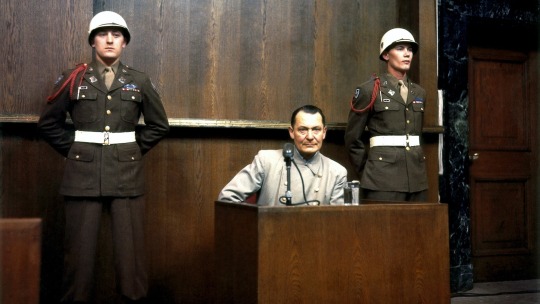
On the photo: Nuremberg Process, 1945
🔬 WHAT ARE POLITICAL OBJECTIVES?
➡️ In a previous publication, I mentioned the concept of political tasks (paragraph 3) - in fact, this is the same task as in mathematics or, say, in physics, which have either a direct or evidential solution.
‼️ Before starting, I would like to give attention to the fact that this is just my point of view. If I make a mistake in reasoning, I ask for your excuses.
➡️ While in mathematics, the tools for solving or proving data conditions in a problem are mathematical operations, formulas, theorems, axioms, etc. In the case of political tasks, these very tools also exist: how "theorems" and "axioms" work, the properties of regimes, types of coups d'état, types of foreign policy, how "formulas" exist laws, codes of honor and glory, codes of the UN, NATO, EU and other social and diplomat. structures.
➡️ And here's the most interesting thing: I will quote and constantly remember the phrase of my acquaintance from Ettlingen, Claudia Klinkenberg, she said back in April 2022 "Russia is simply afraid because it is long, but one thing is clear to the small - it is narrow and fragile from the inside" . The fact is that the Russian Federation does not use and does not consider all events on the so-called. "time line" as "political tasks" - the Russian Federation, like the scoop, like the growing empire, although they have a fairly good military command (again, this is all very relative), they scare far from tactics, and not a raised eyebrow (which threatened the nightingales in the first days of the war) and not even with technology, but with quantity. "THE MANY OF THEM" - they said [📣 please take this as a joke]. In fact, the Russian army is now designed to suppress mass protests, wage war with poorly equipped countries, and is also capable of the brutal destruction of ethnic groups and nations (Georgians, Chechens, Ukrainians, etc.).
➡️ In turn, the Russian Federation doesn’t seem to know about other options for solving their wishes, except to send in troops and shout “everyone don’t move this robbery”, and even if the highest diplomacy knows about possible diplomatic moves, moreover, beneficial for both sides and honest, it doesn’t considers it an adequate way to solve problems because "the lads will fight to the point of blood without any words" [🔔 read this phrase with the type of a tough guy with a gang from the Russian Federation with greetings from the 90s]. Even the most vicious gangs in the West initially negotiate (I won’t be surprised if statements about Mexican or Colombian drug cartels go into the comments - they are still outside my professional competence), and only then they sort it out by force.
➡️ Although Russia (like a scoop along with the entire communist bloc in Asia) is very experienced in spying on neighboring countries and is known for introducing personnel controlled by itself as candidates for local authorities, a more adequate way to solve the so-called. there is no "problem". So the so-called sound is brewing. "Casus Belli", translating into an understandable language, this means a reason for war. And even if you ask for a referendum, there will definitely be at least 5 Russian regional administrations that will falsify the results of the referendum in favor of Russia.
🔰 And what do we have as a result? Let's imagine for a while that the planet is a street, and the country is a person. Ukraine (like Georgia, Poland, the Baltic countries and the entire former western part of the USSR) is a beautiful girl who can finally, after 30 years of slavery, repulse the attacker. rashka is a drunken huckster with a bat who constantly goes to rub someone's ass. In fact, we are at war with a country that, apart from holding pseudo-referendums, destroying nations and ethnic groups with cities, creating a buffer zone for itself, and can do nothing to keep everyone in fear. Remember: the best art is to rule the country not so that all the neighbors respect you because they are afraid **, but so that your country is the best in everything, and the neighbors respect you because of advancement and politeness.
#story
GRIGORYAN LIVE
0 notes